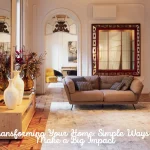Relocating to a new city offers more than just a change of scenery — it presents the perfect opportunity to reimagine your lifestyle, mindset, and home environment. Whether you’re moving for work, education, or simply a new adventure, the process of transitioning from one home to another can feel both exciting and overwhelming. And when you’re traveling from a peaceful place like Ithaca to a bustling city like Boston, the contrast makes the shift even more transformative.
Whether you’re planning a move from Boston to Ithaca by bus or flying across the country, starting over in a new home is both exciting and challenging. Beyond packing boxes and changing your address, there’s the emotional and creative task of turning a new space into something that feels like you.
In this article, we’ll explore how to embrace your relocation as a design opportunity, with tips on decorating, organizing, and truly making your next home a reflection of your next chapter.
1. Start with a Clean Slate — Mentally and Physically
Relocating isn’t just about physical movement; it’s about mental and emotional reset, too. Use this time to reflect on what worked (and didn’t) in your previous home. What made you feel at peace? What stressed you out?
When packing, be intentional. Don’t bring everything — especially not items that carry clutter or negative associations. Let go of furniture or décor that no longer suits your evolving style. Think of this move as a chance to edit your life, just like an interior designer curates a space.
2. Research the New City’s Vibe and Architecture
Boston has a rich architectural heritage that blends historical charm with modern design. If you’re arriving from Ithaca, where cozy college-town aesthetics dominate, Boston’s brick buildings, narrow streets, and classic brownstones might feel like a bold shift.
Before you settle into decorating, take a walk around your new neighborhood. Snap photos of window boxes, colors, or materials that catch your eye. This local inspiration can help you align your interior design with the environment outside — creating harmony between home and city.
3. Prioritize Function Before Form
Moving into a new place — especially in a fast-paced city like Boston — often means dealing with less space or different layouts. Before buying new furniture or unpacking all your boxes, observe how you live in the space.
Ask yourself:
- Where does natural light fall during the day?
- Which areas are high-traffic zones?
- Do you need more storage or more seating?
By understanding how the space functions, you can design around real-life use rather than idealized Pinterest boards.
4. Invest in Foundational Pieces
A new home deserves thoughtful, timeless pieces — not just rushed purchases to fill a space. Once you’ve figured out your layout, invest in a few high-quality items:
- A comfortable, stylish sofa
- A durable dining table
- Storage solutions that reduce visual clutter
These anchor pieces will define your space’s tone. Layer in smaller accents — throw pillows, rugs, lighting — that reflect your personality and can be changed easily over time.
5. Add Meaning with Local Finds
One of the best parts of starting fresh in a new city is discovering local markets, galleries, and boutiques. Look for artwork by local artists, vintage shops with unique décor, or flea markets where you can pick up conversation pieces.
These local finds not only support your new community but also bring a deeper layer of authenticity to your home.
6. Bring a Touch of the Old — But Make It New
Your past is part of your story — so don’t feel like you have to abandon everything. Instead, reimagine it.
Did you love a bookshelf in your Ithaca apartment? Maybe give it a fresh coat of paint to match your Boston palette. That well-worn armchair? Add a modern throw. Combining the old with the new creates continuity while still embracing change.
7. Create a “Landing Zone” for Peace of Mind
The early days in a new home can feel chaotic — boxes everywhere, unfamiliar surroundings, and new routines. Carve out one area of your home as a “landing zone” that brings calm and familiarity. It could be:
- A reading nook with your favorite chair and lamp
- A morning coffee corner by the window
- A gallery wall with framed memories
This helps ground you during the adjustment period and gives you a space to breathe.
8. Embrace the Journey, Not Just the Destination
Moving from one city to another — like taking the Boston to Ithaca bus and watching the scenery change from serene Finger Lakes to urban skylines — is symbolic of your life shift. There will be bumps, detours, and delightful surprises.
Give yourself permission to decorate slowly. Let the space evolve with you. You don’t need to have it all perfect by week one. The most beautiful homes are built layer by layer, just like personal growth.
Conclusion: A Home That Reflects Who You Are Becoming
Relocating is rarely easy, but it’s a powerful opportunity to reimagine what “home” means. With thoughtful design choices, meaningful items, and a little patience, you can turn your new city dwelling into a space that feels truly yours.
So whether you’re boarding the Boston to Ithaca bus with a suitcase full of dreams or unpacking your life one box at a time — embrace this fresh start. A new home is not just where you live. It’s where you grow, love, and redefine who you are.










